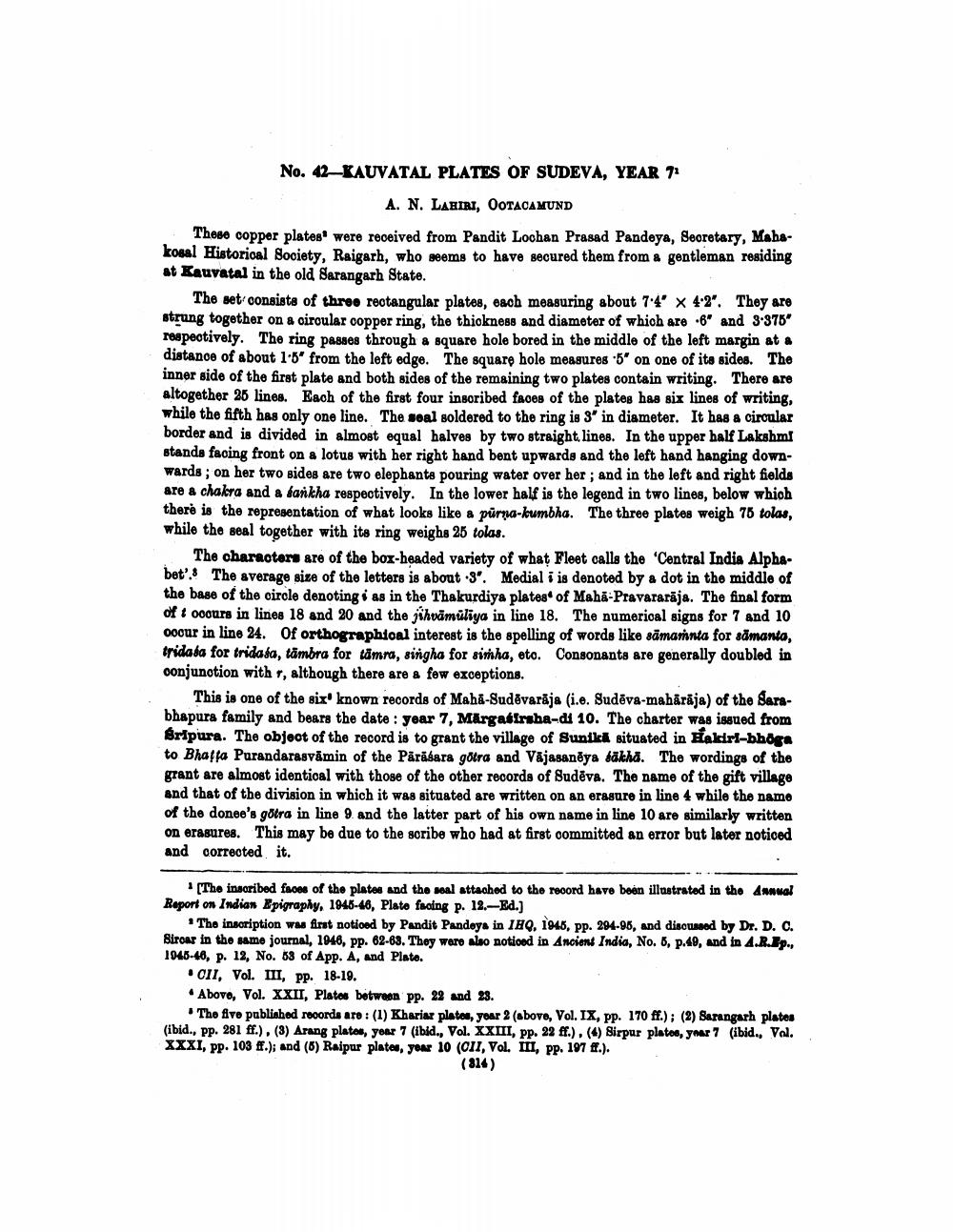________________
No. 42–KAUVATAL PLATES OF SUDEVA, YEAR 72
A. N. LAHIRI, OOTACAMUND These copper plates were received from Pandit Lochan Prasad Pandeya, Secretary, Mahakosal Historical Society, Raigarh, who seems to have secured them from a gentleman residing at Kauvatal in the old Sarangarh State.
The set consists of thres rectangular plates, each measuring about 7:4" X 4.2". They are strung together on a ciroular copper ring, the thickness and diameter of which are .6" and 3.375" respectively. The ring passes through a square hole bored in the middle of the left margin at a distance of about 1.8' from the left edge. The square hole measures 5' on one of its sides. The inner side of the first plate and both sides of the remaining two plates contain writing. There are altogether 26 lines. Each of the first four insoribed faces of the plates has six lines of writing, while the fifth has only one line. The soal soldered to the ring is 3' in diameter. It has a circular border and is divided in almost equal halves by two straight lines. In the upper half Lakshmi stands facing front on a lotus with her right hand bent upwards and the left hand hanging downwards ; on her two sides are two elephants pouring water over her; and in the left and right fields are a chakra and a farkha respectively. In the lower half is the legend in two lines, below which there is the representation of what looks like & pürna-kumbha. The three plates weigh 75 tolas, while the seal together with its ring weighs 25 tolas.
The characters are of the box-headed variety of what Fleet calls the 'Central India Alphabet'. The average size of the letters is about 3'. Medial i is denoted by a dot in the middle of the base of the circle denotingi as in the Thakurdiya plates of Maha-Pravararāja. The final form of tooours in lines 18 and 20 and the Jihvāmüliya in line 18. The numerical signs for 7 and 10 ooour in line 24. Of orthographioal interest is the spelling of words like såmannta for samanta, tridata for tridasa, tämbra for timna, singha for simha, eto. Consonants are generally doubled in conjunotion with, although there are a few exceptions.
This is one of the six' known records of Maha-Sudēvarāja (i.e. Sudēva-mahārāja) of the Serabhapura family and bears the date : year 7, Märgatireba-di 10. The charter was issued from Bripura. The objoot of the record is to grant the village of Sunikk situated in Haldri-bhoga to Bhaffa Purandarasvămin of the Pārāśara gotra and Vājasaněya bökha. The wordings of the grant are almost identical with those of the other records of Sudēva. The name of the gift village and that of the division in which it was situated are written on an erasure in line 4 while the name of the donee's gotra in line 9. and the latter part of his own name in line 10 are similarly written on erasures. This may be due to the scribe who had at first committed an error but later noticed and corrected it.
(Tho inscribed faces of the plates and the soal attached to the record have been illustrated in the annual Report on Indian Epigraphy, 1946-48, Plato faoing p. 12.-Ed.)
The inscription was first noticed by Pandit Pandays in IHO, 1946, pp. 294-96, and discussed by Dr. D. C. Siroar in the same journal, 1946, pp. 62-68. They were also notioed in Ancient India, No. 8, p.49, and in 4.R.Ep., 1048-46, p. 12, No. 68 of App. A, and Plato.
CII, Vol. III, PP. 18-19. . Abovo, Vol. XXII, Plates between pp. 22 and 23.
• The five published rooords aro: (1) Khariar plates, year 2 (above, Vol. IX, pp. 170 ff.); (2) Sarangarh plates (ibid., pp. 281 ff.), (3) Arang platou, year 7 (ibid., Vol. XXIII, pp. 22 ff.). (4) Sirpur platos, ynar 7 (ibid., Val. XXXI, pp. 103 ff.); and (6) Raipur plates, your 10 (CII, Vol. III, PP. 197 ff.).
(814)




